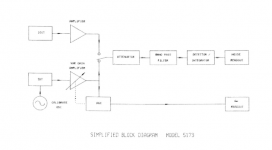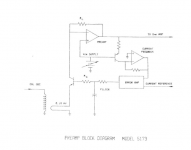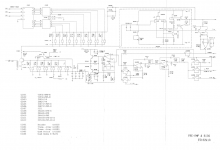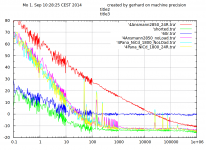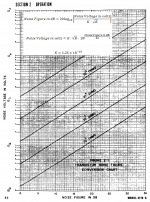I would like a new day version of the Quantech as well. The supply/biasing/preamp circuit is complex with several floating supplies and switching for n/p devices that make it complex. The rest would be easy.
Can you show me a block diagram?
Can you show me a block diagram?
You guys are dwelling in the past, verifing the noise performance of a BJT is not that hard. THAT has low noise PNP's and NPN's and the MAT03/MAT02 pairs are there too as well as the SSM replacements.
Last edited:
I'll post a scan of the later version Quantech this evening. The opamp variation is simple by comparison. Need PC software w/ noise analysis to make it useful. Maybe a subset of hpw?
A little behind schedule but here is a block diagram of the 5173, the preamp section and just the first page of the preamp circuit. Somewhat like a curve tracer there are a lot of interacting pieces to make one of these. Mine was hijacked into Constellation production and I have not been able to get it back yet. Finding another is quite difficult.
It may be easier to limit the options some and make it more manual. I have the schematics for the older 2173 but I need to scan those as well.
Attachments
Thank you very much for the Quantech circuits, I was after them for quite some time.
Over the weekend I have made some progress on automating my Agilent 89441A,
the preamp, gnuplot and the control program on Linux Mint. I had allocated some buffers
locally in procedures and got stack overflows, resulted in really wierd and unpredictable
behaviour.... That much for 16 Gig physical RAM and unlimited swap space. :-(
I could make a few measurements on noise density of some batteries:
Ansmann NiMH 2850 mAh AA size with no load and 2*47R wire wound
Panasonic/Sanyo NiCd 1800 mAh C size with no load and 2*47R
Bottom traces are the own voltage noise of the preamp ( 10 pairs of ADA4898-2 in par.)
The dark blue line is the voltage noise of 60R thin film, i.e 1nV/sqrt Hz taken
as reference -> 0dB relative.
It's interesting that the NiMH gets that noisy under load, should be abt. 200mA DC.
There are still some effects that need to be considered, for example the noise below
100 Hz seems to be somehow different and the spurious I get varies too much for my taste.
I need a lot of gain to swamp the 1/f noise of the FFT analyzer.
Over the weekend I have made some progress on automating my Agilent 89441A,
the preamp, gnuplot and the control program on Linux Mint. I had allocated some buffers
locally in procedures and got stack overflows, resulted in really wierd and unpredictable
behaviour.... That much for 16 Gig physical RAM and unlimited swap space. :-(
I could make a few measurements on noise density of some batteries:
Ansmann NiMH 2850 mAh AA size with no load and 2*47R wire wound
Panasonic/Sanyo NiCd 1800 mAh C size with no load and 2*47R
Bottom traces are the own voltage noise of the preamp ( 10 pairs of ADA4898-2 in par.)
The dark blue line is the voltage noise of 60R thin film, i.e 1nV/sqrt Hz taken
as reference -> 0dB relative.
It's interesting that the NiMH gets that noisy under load, should be abt. 200mA DC.
There are still some effects that need to be considered, for example the noise below
100 Hz seems to be somehow different and the spurious I get varies too much for my taste.
I need a lot of gain to swamp the 1/f noise of the FFT analyzer.
Attachments
Last edited:
The curves on page 2-3 fit a very simple equation, see attached. Try out a few example points on the plot as test cases; you'll see the fit is pretty tight. (As you'd expect from the simplicity of the curves)
Attachments
I just found and ordered a few hundred pieces of its brother device (same process, better noise specs), the MPS6571, at a NOS wholesaler. I thought they were unobtainable. Testing might possibly reveal that these are, um, not quite the genuine articleHow about the MPSA18?
Still, I expect to find Rbb' in the vicinity of 500-1000 ohms.
I found data on the MPSA18. ... The measured Rbb is given as 900 Ohms.
I could make a few measurements on noise density of some batteries:
Ansmann NiMH 2850 mAh AA size with no load and 2*47R wire wound
Panasonic/Sanyo NiCd 1800 mAh C size with no load and 2*47R
Bottom traces are the own voltage noise of the preamp ( 10 pairs of ADA4898-2 in par.)
The dark blue line is the voltage noise of 60R thin film, i.e 1nV/sqrt Hz taken
as reference -> 0dB relative.
It's interesting that the NiMH gets that noisy under load, should be abt. 200mA DC.
There are still some effects that need to be considered, for example the noise below
100 Hz seems to be somehow different and the spurious I get varies too much for my taste.
I need a lot of gain to swamp the 1/f noise of the FFT analyzer.
It would be good info to have the noise (increases) as the battery is used towards its' end-of-life.
THx-RNMarsh
2N5087 - PNP
1-3mA/ 15v
Beta = 460 @ 5mA
raises slightly at 100uA/15v
2.5nv 3.2nv 1.4nv 1.5nv 1.3nv
THx-RNMarsh
John --- Didnt test with 10K in series with base.
-RM
- Home
- Source & Line
- Analog Line Level
- Discrete Opamp Open Design

